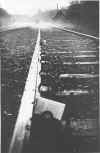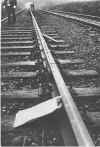The author joined the Research Division of BR in 1974 working initially on technical investigations into freight train derailments. At this time there were still a large number of old 4-wheel wagons (e.g. 16 ton minerals, Vanfits etc) running on BR. We were usually called in by the local Area Manager if the cause of the derailment was not immediately apparent e.g. a broken axle
We had a car at our disposal loaded with equipment such as a theodolite and staff for track surveys, void meters, cant and gauge sticks, measuring tapes and a Polaroid camera (this was the pre-digital age). We were 'on-call' 24hrs a day and sometimes got a callout in the middle of the night and worked until the job was finished. The on-site work usually included a detailed survey of the track, both alignment and top level followed by a minute examination of the rolling stock. Numerous photos were taken and then the survey was plotted onto several graphs to show the state of the line compared to the ideal. On many occasions following our detailed investigations it became obvious where the cause lay, whether it be track or train.
Click on the picture for a bigger image - photos are the author's unless otherwise indicated
|
Here's a nice shot taken on the evening of 23rd July 1974 at the site of a freight train derailment on the line between Bicester and Bletchley near Verney Junction. The technicians are examining the track in front of the site of the derailment looking for tell tale signs. Meanwhile the midden in the background is smoking well, someone is floating on high in a hot air balloon and we're all looking forward to a pint afterwards in the Verney Arms Hotel nearby. |
|
| Next morning a stone train passes the derailment site whilst engineers are investigating the causes of the derailment. Note the measuring devices beneath the rail. These were known as voidmeters and were placed there to record the deflection of the rails as the train passed. The line is now singled and 'mothballed'. | |
|
A view further along the line towards Bicester shows the poor state of the track on this railway in 1974 (Note the misalignments in the rails). Often trains ran for miles with wagons derailed until some track feature was encountered where everything came off. In the background is the original Verney Junction station building. Author's collection |
|
| Another view of the line showing the misalignment of the track
'top' at this location.
Author's collection |
|
| A class 47-hauled train of SPV's causes interest from the engineers as it passes the site of the derailment at Verney Junction. | |
| An empty stone train en route for the Western Region heads for Oxford past the site of the derailment at Verney Junction. | |
| In this picture stones have
been used to mark the route of the derailed wheel as it crossed the
railhead - this particular site was near Ferryhill, Co Durham and
shows two flange marks
Author's collection |
|
|
This device was developed by R&DD for use in the investigation of derailments. Called a tyre profile machine it had a probe which was traced across the wheel tread and drew its profile on a piece of translucent (and waterproof) paper. Each wheel was copied and these were later compared in the office to the correct new profile with sometimes unexpected results. It was also used to measure the profile of the rail head which was also compared with the ideal new profile. Author's collection |
|
|
6M57 passes the site of another derailment near Market Rasen, Lincolnshire sometime in 1975. Note the voidmeters under the rails. These had a movable arm which was set against underside of the rail when the device was in position between the sleepers. When a train passed the loaded rail moved downwards displacing the arm which remained in its new position. The deflection could be then read off a fixed scale - when plotted this was known as 'loaded rail top'. |
|
| This example is from Mickle
Trafford, Cheshire where a train of Vanfits had come to grief - the
clipboard marks the point of flange climb
Author's collection |
Some of the more interesting call outs however were to passenger train derailments.
At about 10.30 pm on the evening of 23rd January 1975 there was a derailment followed by a collision at Bushey, near Watford on the WCML, which resulted in one of the Class 86 locomotives involved finishing up at the bottom of a 50ft high embankment.
The cause was eventually found to be due to a couple of large steel pallets used for carrying Ford gearboxes from Dagenham to Halewood falling from a passing freight train and landing in the Up line. These were struck by a double-headed 12 coach southbound train, which had a class 83 loco piloting a class 86. The loco was derailed to the six foot side foul of the Down line and was struck a glancing blow by another Class 86 loco heading a night sleeper from Euston. The collision resulted in the northbound loco and first vehicle (a BG) being deflected down the embankment. Fortunately there were no passenger fatalities although the driver of the southbound train was killed.
Recovery of the locomotive took a long time and featured in the contemporary Modern Railways magazine of June 1975. Several of the sleeping cars were pushed down the bank to clear the line and were cut up on site. The site where the locomotive and BG ended up is now built upon.
















